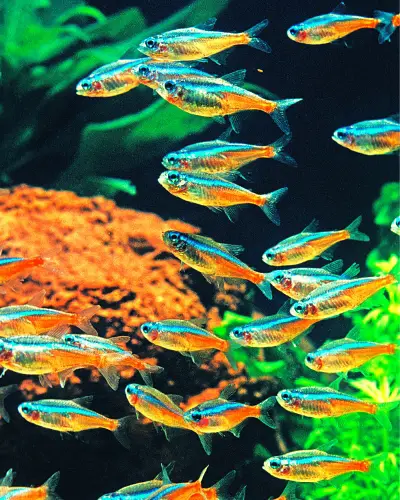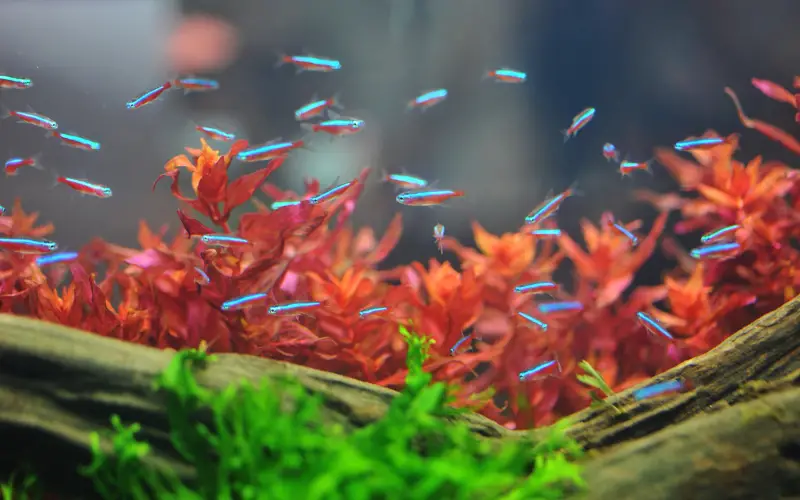Neon Tetras are among the most popular freshwater aquarium fish, known for their vibrant colors and peaceful demeanor. Breeding Neons can be a rewarding but delicate process that requires a deep understanding of their natural behaviors and needs.
In this article, we will delve into the art of breeding Neons Tetra, focusing on mastering the spawning process to ensure successful reproduction.
From creating the ideal breeding setup to providing the right water conditions and diet, Neon tetras breeding requires careful planning and observation.

Breeders can increase the likelihood of successful spawning by understanding the mating behaviors of these peaceful fish and mimicking their natural habitat.
Mastering the breeding process of Neons Tetra can lead to a thriving and colorful aquarium population through patience, dedication, and a keen eye for detail. Join us on this journey to learn more about the art of breeding these mesmerizing fish.
Table of Contents
ToggleIs Breeding Neon Tetras Hard?
Breeding neon tetra fish is easier than it may seem, especially if you have the right tank conditions. Neon tetras like to lay eggs in planted tanks, so make sure your tank has plenty of java moss and leaf litter for them to spawn.
You can also use oak leaves to help create an acidic environment that mimics their natural habitat. Remove the adults from the tank once the eggs are laid, as they may eat them. The eggs will hatch within 24 to 48 hours, and the fry will start feeding on infusoria and baby brine shrimp within two days.

Keeping the water parameters stable is important, so regular water changes are necessary. Neon tetras prefer soft water with a pH of around 6.5 to 7.0.
You can also use RO water to ensure the water is clean and free of any contaminants. Keep the tank stable using a heater around 75-80 degrees Fahrenheit.
As the fry grows, you can feed them microworms and live baby brine shrimp to ensure they have enough to eat. Neon tetra babies will typically be large enough to join the rest of the school at around 12 weeks old.
How to Set up a Neon Tetra Breeding Tank?
Setting up a neon tetra breeder tank is essential for successful fish breeding. Start by selecting a new tank of at least 10 gallons, as neon tetras are easy to breed and require an aquatic environment.
Remember that neon tetras are tropical fish, so maintaining a regular tank temperature of around 75-80 degrees Fahrenheit is crucial.
Place a few cardinal tetras in the tank to trigger egg spawning. Once you notice eggs, remove the adult neons from the tank to keep the eggs safe. A dim light around the tank helps trigger the neon tetras to breed. Shine a flashlight on the tank at night to see if there are any eggs.
If you see eggs, quickly remove them using a clean towel or sponge. Place the eggs in a separate container with fresh rainwater and add a few drops of methylene blue to prevent fungal growth. Within 24 hours, the eggs should hatch, and you will have free-swimming neon tetra fry around the tank.
Change the water in the container every few hours to keep the fry healthy. Once the fry has hatched, feed them with food like paramecium to help them grow.
After a few days, you can feed them baby brine shrimp or crushed flake food. To keep the bottom of the tank clean, add a small filter or a group of snails to help with filtration. You can also place a sponge or grate on the bottom of the tank to prevent the eggs from falling through.
If the eggs turn white or fungus starts to grow, gently scrub them with a soft brush and add a few drops of methylene blue to prevent further contamination. Keep the tank in a dark environment to prevent the fry from getting stressed.
How to Breed Neon Tetras in a Home Tank (Breeding Neons)
Breeding Neon tetras in a home tank can be a rewarding experience, but it requires careful attention to detail. If you want to breed Neon Tetras, you will need a breeding tank with plenty of fern or other plants for them to lay their eggs. When the female is ready to spawn, she will scatter her eggs among the plants.
The eggs fall to the bottom of the tank, where they will hatch and fry in about 24-36 hours. Removing the adult Tetras after spawning is essential to prevent them from eating the eggs and fry. The fry can be fed microworms or infusoria until they are large enough to eat baby brine shrimp.
I’ve bred Neon Tetras a few times and found that keeping the water in the breeding tank soft and slightly acidic helps encourage spawning.
I prepare the breeding tank by adding a layer of peat moss and using suction to remove any debris. Before adding the breeding pair of Tetras, I rinse the peat moss with tap water to remove any excess tannins.
For optimal breeding conditions, the water in the breeding tank should be kept at around 78-80°F and the pH between 6.0 and 6.5.
How to Get Neon Tetra Eggs?
Neon tetras are known for their beautiful colors and peaceful nature. Many fishkeeping enthusiasts enjoy breeding these fish in their tanks, but getting their eggs can be challenging. I am still determining the exact process, but one method is to provide a softness for the fish to lay their eggs on.
This can be done by placing a towel at the bottom of the tank. After the eggs are laid, hatching typically takes 4 to 5 hours. Many tetras are similar to rasbora so the first few attempts may be unsuccessful. However, with patience and perseverance, you may eventually succeed.
Here’s how to get neon tetra eggs:
- Separate Breeding Tank: Set up a small tank (2-5 gallons) with soft, slightly acidic water (pH 6.0-7.0) and dimmed lighting.
- Spawning Triggers: Use aged water, add java moss for hiding and egg-laying, and slightly raise the water temperature (a few degrees).
- Conditioning Breeders: Separate healthy adult tetras and feed them live food to stimulate breeding for a few weeks.
- Introduce Breeders: Once conditioned, add the tetras to the breeding tank in the evening.
- Look for Eggs: After 1-2 days, check for tiny clear eggs scattered amongst the java moss (adults will likely eat them if left in).
Tips for Successful Neon Tetra Breeding
When breeding Neon Tetras, creating a conducive environment for the fish is essential. Provide them with plenty of hiding spots, plants, and soft, acidic water.
Ensuring suitable water parameters, with a slightly cooler temperature and low lighting, can also help induce breeding behavior.
Additionally, feeding the fish a varied protein-rich diet can increase their chances of successful breeding. Removing the towel after spawning is essential, as the adult fish might eat the eggs.
Lastly, I don’t think breeding Neon Tetras will be easy—it requires patience, dedication, and attention to detail. However, with the right conditions and care, you can successfully breed these beautiful fish in your home aquarium.
Commonly Asked Questions about Breeding Neon Tetras In Aquariums (FAQs)
How do we keep neon tetras from breeding?
Neon tetras or paracheirodon innesi thrive in stable conditions. To prevent breeding, maintain regular water changes and avoid overfeeding. Don’t mimic breeding triggers like lower water levels or increased temperatures.
Do neon tetras breed easily?
Neon tetras can spawn in captivity, but successfully raising fry is challenging. They require specific water conditions and separate breeding tanks to avoid egg predation by other fish.
Will tetras breed in a community tank?
Tetra breeding in community tanks is possible but unlikely. Their eggs are vulnerable, and other fish might eat them. For successful breeding, a separate tank with specific water parameters is ideal.
How to tell if neon tetra is male or female?
How to identify male and female glow tetra? Distinguish male from female neon tetras by body shape: males are slimmer with a straight blue line, while females are rounder with a slightly curved blue line.
How big of a tank do two neon tetras need?
While two neon tetras can survive in a 10-gallon tank, ideally, they need a minimum of 20 gallons. They thrive in schools, so a bigger tank (20+) is best for their health and happiness.
Are female tetras bigger than males?
In many tetra species, females are larger and rounder than males. Males tend to be slimmer with a more streamlined body.
Are neon tetras okay in the dark?
Yes, paracheirodon innesi tetras are okay in the dark. They can be sensitive to light and prefer dimmed or planted tanks with hiding spots.
How long does neon tetra disease last?
Neon tetra disease is often fatal. Its progression is rapid, and in its final stages, fish become increasingly lethargic and sensitive to light.
Conclusion
In conclusion, the art of neon tetras breeding is a captivating endeavor that requires careful attention to detail and a deep understanding of their needs. You can increase the likelihood of successful breeding by creating an optimal breeding environment, selecting healthy breeding pairs, and providing the right conditions. Patience is essential throughout the process, as it may take time for the Tetras to spawn and for the eggs to hatch into fry.
Monitoring water parameters, maintaining appropriate temperature and pH levels, and offering a varied diet are vital for the health and development of the Neon Tetra offspring. Additionally, it is crucial to separate the adults from the eggs or fry to protect them from potential predators.
Breeding Neons is a rewarding experience that allows you to witness the fascinating cycle of life, from the courtship dances to the hatching of tiny, vibrant fry. So, whether you’re an experienced breeder or embarking on this journey for the first time, the world of Neon Tetra breeding is filled with wonder and fulfillment.
Recommended Posts
- Neon Tetra Care Guide for Beginners (Experts Advice)
- Cardinal Tetra Vs Neon Tetra: Which One is (Better for You!)
- Neon Tetra Water Parameters 101: (A Comprehensive Guide)
- The Ideal Neon Tetra Tank Size: A Comprehensive Guide
- Identifying Pregnant Neon Tetra Fish: (3 Proven Symptoms)
- Neon Tetra Life Expectancy: Avoid These 3 Deadly Mistakes!
- How Many Neon Tetras in A 5 Gallons Tank (Best Practices)
- The Exact Neon Tetra Eggs Hatching Time: (Witness the Magic)
- Is My Ember Tetra Pregnant: 5 SHOCKING Signs You Can’t Ignore!




